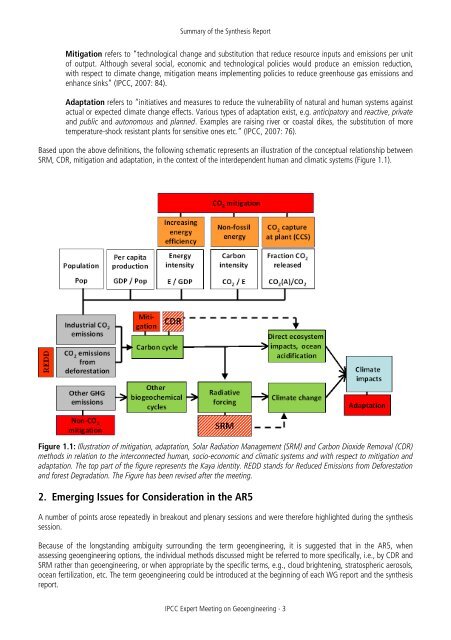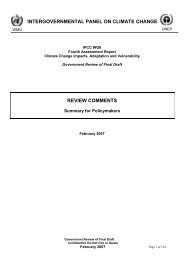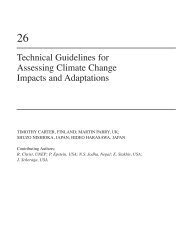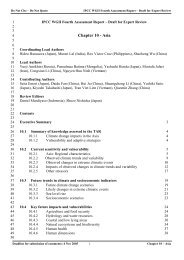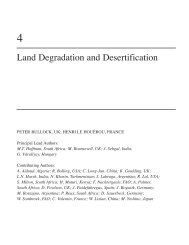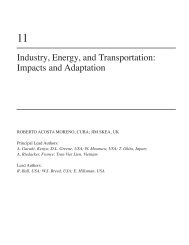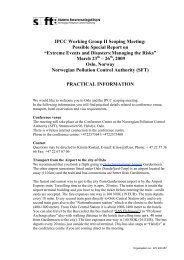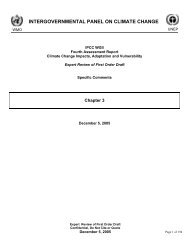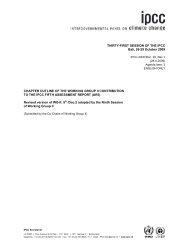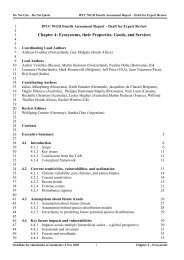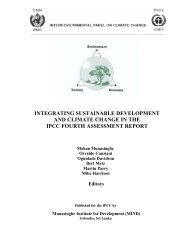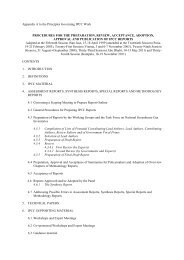IPCC Expert Meeting on Geoengineering
IPCC Expert Meeting on Geoengineering
IPCC Expert Meeting on Geoengineering
You also want an ePaper? Increase the reach of your titles
YUMPU automatically turns print PDFs into web optimized ePapers that Google loves.
Summary of the Synthesis Report<br />
Mitigati<strong>on</strong> refers to “technological change and substituti<strong>on</strong> that reduce resource inputs and emissi<strong>on</strong>s per unit<br />
of output. Although several social, ec<strong>on</strong>omic and technological policies would produce an emissi<strong>on</strong> reducti<strong>on</strong>,<br />
with respect to climate change, mitigati<strong>on</strong> means implementing policies to reduce greenhouse gas emissi<strong>on</strong>s and<br />
enhance sinks” (<str<strong>on</strong>g>IPCC</str<strong>on</strong>g>, 2007: 84).<br />
Adaptati<strong>on</strong> refers to “initiatives and measures to reduce the vulnerability of natural and human systems against<br />
actual or expected climate change effects. Various types of adaptati<strong>on</strong> exist, e.g. anticipatory and reactive, private<br />
and public and aut<strong>on</strong>omous and planned. Examples are raising river or coastal dikes, the substituti<strong>on</strong> of more<br />
temperature-shock resistant plants for sensitive <strong>on</strong>es etc.” (<str<strong>on</strong>g>IPCC</str<strong>on</strong>g>, 2007: 76).<br />
Based up<strong>on</strong> the above definiti<strong>on</strong>s, the following schematic represents an illustrati<strong>on</strong> of the c<strong>on</strong>ceptual relati<strong>on</strong>ship between<br />
SRM, CDR, mitigati<strong>on</strong> and adaptati<strong>on</strong>, in the c<strong>on</strong>text of the interdependent human and climatic systems (Figure 1.1).<br />
Figure 1.1: Illustrati<strong>on</strong> of mitigati<strong>on</strong>, adaptati<strong>on</strong>, Solar Radiati<strong>on</strong> Management (SRM) and Carb<strong>on</strong> Dioxide Removal (CDR)<br />
methods in relati<strong>on</strong> to the interc<strong>on</strong>nected human, socio-ec<strong>on</strong>omic and climatic systems and with respect to mitigati<strong>on</strong> and<br />
adaptati<strong>on</strong>. The top part of the figure represents the Kaya identity. REDD stands for Reduced Emissi<strong>on</strong>s from Deforestati<strong>on</strong><br />
and forest Degradati<strong>on</strong>. The Figure has been revised after the meeting.<br />
2. Emerging Issues for C<strong>on</strong>siderati<strong>on</strong> in the AR5<br />
A number of points arose repeatedly in breakout and plenary sessi<strong>on</strong>s and were therefore highlighted during the synthesis<br />
sessi<strong>on</strong>.<br />
Because of the l<strong>on</strong>gstanding ambiguity surrounding the term geoengineering, it is suggested that in the AR5, when<br />
assessing geoengineering opti<strong>on</strong>s, the individual methods discussed might be referred to more specifically, i.e., by CDR and<br />
SRM rather than geoengineering, or when appropriate by the specific terms, e.g., cloud brightening, stratospheric aerosols,<br />
ocean fertilizati<strong>on</strong>, etc. The term geoengineering could be introduced at the beginning of each WG report and the synthesis<br />
report.<br />
<str<strong>on</strong>g>IPCC</str<strong>on</strong>g> <str<strong>on</strong>g>Expert</str<strong>on</strong>g> <str<strong>on</strong>g>Meeting</str<strong>on</strong>g> <strong>on</strong> <strong>Geoengineering</strong> - 3


